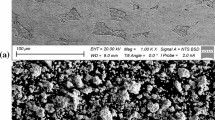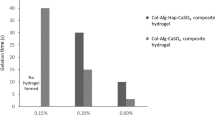Abstract
Friction stir processing (FSP) was successfully adopted to fabricate nano-hydroxyapatite (nHA) reinforced AZ31 magnesium alloy composite as well as to achieve fine grain structure. The combined effect of grain refinement and the presence of embedded nHA particles on enhancing the biomineralization and controlling the degradation of magnesium were studied. Grain refinement from 56 to ~4 and 2 μm was observed at the stir zones of FSP AZ31 and AZ31–nHA composite respectively. The immersion studies in super saturated simulated body fluid (SBF 5×) for 24 h suggest that the increased wettability due to fine grain structure and nHA particles present in the AZ31–nHA composite initiated heterogeneous nucleation which favored the early nucleation and growth of calcium-phosphate mineral phase. The nHA particles as nucleation sites initiated rapid biomineralization in the composite. After 72 h of immersion the degradation due to localized pitting was observed to be reduced by enhanced biomineralization in both the FSPed AZ31 and the composite. Also, best corrosion behavior was observed for the composite before and after immersion test. MTT assay using rat skeletal muscle (L6) cells showed negligible toxicity for all the processed and unprocessed samples. However, cell adhesion was observed to be more on the composite due to the small grain size and incorporated nHA.











Similar content being viewed by others
References
Song GL. Control of biodegradation of biocompatible magnesium alloys. Corros Sci. 2007;49:1696–701.
Witte F, Hort N, Vogt C, Cohen S, Kainer KU, Willumeit R, Feyerabend F. Degradable biomaterials based on magnesium corrosion. Curr Opin Solid State Mater Sci. 2008;12:63–72.
Witte F, Fischer J, Nellesen J, Crostack H-A, Kaese V, Pisch A, Beckmann F, Windhagen H. In vitro and in vivo corrosion measurements of magnesium alloys. Biomaterials. 2006;27:1013–8.
Li J, Song Y, Zhang S, Zhao C, Zhang F, Zhang X, Cao L, Fan Q, Tang T. In vitro responses of human bone marrow stromal cells to a fluoridated hydroxyapatite coated biodegradable Mg–Zn alloy. Biomaterials. 2010;31:5782–8.
Wang Y, Wei M, Gao J, Hu J, Zhang Y. Corrosion process of pure magnesium in simulated body fluid. Mater Lett. 2008;62:2181–4.
Sigrid K, Brunner JG, Fabry B, Virtanen S. Control of magnesium corrosion and biocompatibility with biomimetic coatings. J Biomed Mater Res B. 2011;96(1):84–90.
Song GL, Atrens A. Corrosion mechanisms of magnesium alloys. Adv Eng Mater. 1999;1:11–33.
Hornberger H, Virtanen S, Boccaccini AR. Biomedical coatings on magnesium alloys—a review. Acta Biomater. 2012;8:2442–55.
Shaylin S, George JD. Calcium phosphate coatings on magnesium alloys for biomedical applications: a review. Acta Biomater. 2012;8:20–30.
Wang H, Estrin Y, Zúberová Z. Bio-corrosion of a magnesium alloy with different processing histories. Mater Lett. 2008;62:2476–9.
Wang H, Estrin Y, Fu H, Song GL, Zúberová Z. The effect of pre-processing and grain structure on the bio-corrosion and fatigue resistance of magnesium alloy AZ31. Adv Eng Mater. 2007;9:967–72.
Suchank W, Yoshimura M. Processing and properties of hydroxyapatite-based biomaterials for use as hard tissue replacement implants. J Mater Res. 1998;13:94–117.
Mishra RS, Ma ZY. Friction stir welding and processing. Mater Sci Eng. 2005;50:1–78.
Mishra RS, Mahoney MW, McFadden SX, Mara NA, Mukherjee AK. High strain rate super plasticity in a friction stir processed 7075 Al alloy. Scr Mater. 2000;42:163–8.
Mishra RS, Ma ZY, Charit I. Friction stir processing: a novel technique for fabrication of surface composite. Mater Sci Eng A. 2003;341:307–10.
Morisada Y, Fujii H, Nagaoka T, Nogi K, Fukusumi M. Fullerene/A5083 composites fabricated by material flow during friction stir processing. Composites A. 2007;38:2097–101.
Lee W-B, Lee C-Y, Kim M-K, Yoon J-I, Kim Y-J, Yoen Y-M, Jung S-B. Microstructures and wear property of friction stir welded AZ91Mg/SiC particle reinforced composite. Compos Sci Technol. 2006;66:1513–20.
Chen T-J, Zhu Z-M, Li Y-D, Ma Y, Hao Y. Friction stir processing of thixoformed AZ91D magnesium alloy and fabrication of Al-rich surface. Trans Nonferr Met Soc China. 2010;20:34–42.
Lee CJ, Huang JC, Hsieh PJ. Mg based nano-composites fabricated by friction stir processing. Scr Mater. 2006;54:1415–20.
Azizieh M, Kokabi AH, Abachi P. Effect of rotational speed and probe profile on microstructure and hardness of AZ31/Al2O3 nanocomposites fabricated by friction stir processing. Mater Des. 2011;32:2034–41.
Asadi P, Faraji G, Besharati MK. Producing of AZ91/SiC composite by friction stir processing. Int J Adv Manuf Technol. 2010;51:247–60.
Asadi P, Faraji G, Masoumi A, Besharati GM. Experimental investigation of magnesium-base nanocomposite produced by friction stir processing: effects of particle types and number of friction stir processing passes. Metall Mater Trans A. 2011;42(9):2820. doi:10.1007/s11661-011-0698-8.
ASTM Standard E112-12. Standard test methods for determining average grain size. West Conshohocken, PA: ASTM International; 2012. doi:10.1520/E0112-12.
Rameshbabu N, Prasad Rao K, Sampath Kumar TS. Accelerated microwave processing of nanocrystalline hydroxyapatite. J Mater Sci. 2005;40:6319–23.
Wenzel Robert N. Resistance of solid surfaces to wetting by water. Ind Eng Chem. 1936;28:988–94.
Kokubo T, Takadama H. How useful is SBF in predicting in vivo bone bioactivity? Biomaterials. 2006;27:2907–15.
Xu L, Zhang E, Yin D, Zeng S, Yang K. In vitro corrosion behaviour of Mg alloys in a phosphate buffered solution for bone implant application. J Mater Sci Mater Med. 2008;19:1017–25.
ASTM Standard G31-72. Standard practice for laboratory immersion corrosion testing of metals. West Conshohocken, PA: ASTM International; 2004. doi:10.1520/G0031-72R04.
Mansfeld F. The polarization resistance technique for measuring corrosion currents. In: Fontana MG, Staehle RW, editors. Advances in corrosion science and technology, vol 6. New York: Plenum Press; 1976. p. 163–262.
Mosmann T. Rapid colorimetric assay for cellular growth and survival: application to proliferation and cytotoxicity assays. J Immunol Methods. 1983;65:55–63.
Wilson CJ, Clegg RE, Leavensley DI, Pearcy MJ. Mediation of biomaterial–cell interactions by adsorbed proteins: a review. Tissue Eng. 2005;11:1–18.
Hosokawa M, Nogi K, Naito M, Yokoyama T. Nanoparticle technology handbook. Amsterdam: Elsevier; 2007. p. 19–21.
Chatopadhyay R. Surface wear: analysis, treatment, and prevention. Materials Park: ASM International; 2001. p. 1–51.
Juhasz JA, Best SM, Auffret AD, Bonfield W. Biological control of apatite growth in simulated body fluid and human blood serum. J Mater Sci Mater Med. 2008;19:1823–9.
Kim HM, Himeno T, Kawashita M, Kokubo T, Nakamura T. The mechanism of biomineralization of bone-like apatite on synthetic hydroxyapatite: an in vitro assessment. J R Soc Interface. 2004;1:17–22.
Alvarez-Lopez M, Pereda MD, Valle JA, Fernandez-Lorenzo M, Garcia-Alonso MC, Ruano OA, Escudero ML. Corrosion behaviour of AZ31 magnesium alloy with different grain sizes in simulated biological fluids. Acta Biomater. 2010;6:1763–71.
Song Y, Shan D, Chen R, Zhang F, Han EH. Biodegradable behaviors of AZ31 magnesium alloy in simulated body fluid. Mater Sci Eng C. 2009;29:1039–45.
Ratna Sunil B, Sampath Kumar TS, Chakkingal U. Bioactive grain refined magnesium by friction stir processing. Mater Sci Forum. 2012;710:264–9.
Ben Hamu G, Eliezer D, Wagner L. The relation between severe plastic deformation microstructure and corrosion behavior of AZ31 magnesium alloy. J Alloy Compd. 2009;468:222–9.
Hoog C, Birbilis N, Estrin Y. Corrosion of pure Mg as a function of grain size and processing route. Adv Eng Mater. 2008;10:579–82.
Argade GR, Panigrahi SK, Mishra RS. Effects of grain size on the corrosion resistance of wrought magnesium alloys containing neodymium. Corros Sci. 2012;58:145–51.
Witte F, Feyerabend F, Maier P, Fischer J, Stormer M, Blawert C, Dietzel W, Hort N. Biodegradable magnesium–hydroxyapatite metal matrix composites. Biomaterials. 2007;28:2163–74.
Pardo A, Feliu S, Merino MC, Arrabal R, Matykina E. Electrochemical estimation of the corrosion rate of magnesium/aluminium alloys. Int J Corrros. 2009;2010:1–8. doi:10.1155/2010/953850.
Shi Z, Atrens A. An innovative specimen configuration for the study of Mg corrosion. Corros Sci. 2011;53:226–46.
Kirkland T, Birbilis N, Staiger MP. Assessing the corrosion of biodegradable magnesium implants: a critical review of current methodologies and their limitations. Acta Biomater. 2012;8:925–36.
Xiaomei L, Jung YL, Henry JD, Ravi D, Andrea MM, Erwin AV. Influence of substratum surface chemistry/energy and topography on the human fetal osteoblastic cell line hFOB 1.19: phenotypic and genotypic responses observed in vitro. Biomaterials. 2007;28:4535–50.
Acknowledgments
Authors would like to thank Prof. K Prasad Rao, IIT Madras for providing the NRB supported FSP facility.
Author information
Authors and Affiliations
Corresponding author
Rights and permissions
About this article
Cite this article
Ratna Sunil, B., Sampath Kumar, T.S., Chakkingal, U. et al. Nano-hydroxyapatite reinforced AZ31 magnesium alloy by friction stir processing: a solid state processing for biodegradable metal matrix composites. J Mater Sci: Mater Med 25, 975–988 (2014). https://doi.org/10.1007/s10856-013-5127-7
Received:
Accepted:
Published:
Issue Date:
DOI: https://doi.org/10.1007/s10856-013-5127-7




